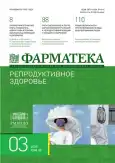Анализ эффективности скрининга первого триместра по задержке роста плода на примере Краснодарского края (когортное исследование)
- Авторы: Пенжоян Г.А.1, Мингалева Н.В.1, Макухина Т.Б.1
-
Учреждения:
- Кубанский государственный медицинский университет
- Выпуск: Том 32, № 3 (2025)
- Страницы: 82-87
- Раздел: Оригинальные статьи
- Статья опубликована: 13.08.2025
- URL: https://journals.eco-vector.com/2073-4034/article/view/688961
- DOI: https://doi.org/10.18565/pharmateca.2025.3.82-87
- ID: 688961
Цитировать
Полный текст
Аннотация
Обоснование: Антенатальное выявление задержки роста плода (ЗРП) имеет неоспоримые преимущества, поскольку тщательное наблюдение за плодом и оптимизированные сроки родов позволяют кратно снизить частоту неблагоприятных перинатальных исходов. Эффективность раннего скрининга c целью выделения группы высокого риска и профилактики ЗРП на базе алгоритма, предложенного Fetal Medicine Foundation (FMF), на популяционном уровне малоизучена.
Цель исследования: оценить эффективность модели скрининга задержки роста плода в первом триместре, разработанной FMF, на когорте женщин, получающих помощь по беременности и родам в Краснодарском крае.
Материалы и методы: Обсервационное ретроспективное исследование данных о результатах комбинированного пренатального скрининга первого триместра и исходах родов у рожениц Краснодарского края на базе анализа официальных отчетов, сведений по форме 32 Росстата по Краснодарскому краю и Перинатальному центру ГБУЗ ККБ № 2 МЗ Краснодарского края за 8 лет (2017–2024 гг.) с целью оценки эффективности скрининга и профилактики ЗРП по динамике частоты рождения детей с ЗРП в скринируемой когорте; определяли значимость различий при сравнении данных за определенные временные промежутки, значимыми считали различия при уровне р<0,05.
Результаты: В исследование включены данные перинатальных исходов родов: n=254 467 в 2017–2020 гг. (до внедрения расчета риска ЗРП), n=218318 в 2021–2024 гг. (после внедрения). Не выявлено значимых различий в частоте мертворождений, неонатальной смертности без учета срока гестации на момент родов, а также в уровне неонатальной заболеваемости среди недоношенных новорожденных до и после внедрения программы скрининга и профилактики ЗРП согласно алгоритму FMF. Обнаружено значимое (p<0,0001) снижение частоты живорождений с ЗРП независимо от срока гестации и среди недоношенных на 32,2% и 29,2% соответственно. Среди новорожденных после внедрения алгоритма обнаружено снижение общей неонатальной заболеваемости на 11,1% (p<0,0001).
Заключение: Внедрение комбинированного скрининга ЗРП на основе алгоритма FMF с выделением группы высокого риска для последующего тщательного наблюдения сопровождается снижением частоты рождения детей с ЗРП. Значимость влияния программы скрининга на уровень заболеваний неонатального периода, связанных с ЗРП, требует дальнейшего изучения.
Ключевые слова
Полный текст
Об авторах
Григорий Артемович Пенжоян
Кубанский государственный медицинский университет
Email: mingalevaN008@yandex.ru
ORCID iD: 0000-0002-8600-0532
д.м.н., профессор, зав. кафедрой акушерства, гинекологии и перинатологии № 2, Института непрерывного образования
Россия, КраснодарНаталия Вячеславовна Мингалева
Кубанский государственный медицинский университет
Автор, ответственный за переписку.
Email: mingalevaN008@yandex.ru
ORCID iD: 0000-0001-5440-3145
д.м.н., профессор, профессор кафедры акушерства, гинекологии и перинатологии № 2 Института непрерывного образования
Россия, КраснодарТатьяна Борисовна Макухина
Кубанский государственный медицинский университет
Email: soltatiana@mail.ru
ORCID iD: 0000-0003-0536-4500
д.м.н., профессор кафедры акушерства, гинекологии и перинатологии № 2 Института непрерывного образования
Россия, КраснодарСписок литературы
- Selvaratnam R.J., Rolnik D.L., Setterfield M. et al. Combined first-trimester screening for preterm small-for-gestational-age infants: Australian multicenter clinical feasibility study. Ultrasound Obstet Gynecol. 2025 Feb;65(2):183–190. https://dx.doi.org/10.1002/uog.29174
- Selvaratnam R.J., Wallace E.M., Wolfe R. et al. Association between iatrogenic delivery for suspected fetal growth restriction and childhood school outcomes. JAMA. 2021;326(2):145–153. https://dx.doi.org/10.1001/jama.2021.8608
- Курцер М.А., Сичинава Л.Г., Шишкина Д.И. и др. Задержка роста плода: современные критерии диагностики, тактика ведения беременности и родов. Вопросы гинекологии, акушерства и перинатологии. 2023;22(1):5–11. [Kurtser M.A., Sichinava L.G., Shishkina D.I., et al. Fetal growth restriction: current diagnostic criteria, management of pregnancy and labor. Vopr ginekol akus perinatol. (Gynecology, Obstetrics and Perinatology). 2023;22(1):5–11. (In Russ.)]. https://dx.doi.org/10.20953/1726-1678-2023-1-5-11
- Подзолкова Н.М., Денисова Ю.В., Скворцова М.Ю. и др. Синдром задержки роста плода: нерешенные вопросы стратификации рисков, ранней диагностики и акушерской тактики. Вопросы гинекологии, акушерства и перинатологии. 2021;20(5):76–86. [Podzolkova N.M., Denisova Yu.V., Skvortsova M.Yu., Denisova T.V., Shovgenova D.S. Fetal growth restriction: unresolved issues of risk stratification, early diagnosis, and obstetric management. Vopr ginekol akus perinatol. (Gynecology, Obstetrics and Perinatology). 2021;20(5):76–86. (In Russ.)]. https://dx.doi.org/10.20953/1726-1678-2021-5-76-86
- Atallah A., Butin M., Moret S. et al. Fetal growth restriction: underdiagnosed condition with non-optimal screening. J Matern Fetal Neonatal Med. 2022 Dec;35(25):8237–8244. https://dx.doi.org/10.1080/14767058.2021.1967924
- Crovetto F., Triunfo S, Crispi F. et al. Differential performance of first trimester screening in predicting small-for-gestational-age neonate or fetal growth restriction. Ultrasound Obstet Gynecol. 2017;49(3):349–356.
- Papastefanou I., Wright D., Lolos M. et al. Competing-risks model for prediction of small-for-gestational-age neonate from maternal characteristics, serum pregnancy-associated plasma protein-A and placental growth factor at 11–13 weeks’ gestation. Ultrasound Obstet Gynecol. 2021;57(3):392–400.
- He B., Hu C., Zhou Y. First-trimester screening for fetal growth restriction using Doppler color flow analysis of the uterine artery and serum PAPP-A levels in unselected pregnancies. J Matern Fetal Neonatal Med. 2021 Dec;34(23):3857–3861. https://dx.doi.org/10.1080/14767058.2019
- Нормальная беременность. Клинические рекомендации. Москва, 2023. [Normal pregnancy. Clinical guidelines. Moscow, 2023. (In Russ.)].
- Guy G.P., Leslie K., Diaz Gomez D. et al. Effect of routine first-trimester combined screening for pre-eclampsia on small-for-gestational-age birth: secondary interrupted time series analysis. Ultrasound Obstet Gynecol. 2022 Jan;59(1):55–60. https://dx.doi.org/10.1002/uog.23741
- Рюмина И.И., Маркелова М.М., Нароган М.В. и др. Опыт внедрения международных стандартов оценки роста новорожденного INTERGROWTH-21st. Российский вестник перинатологии и педиатрии. 2021;66(1):117–124. [Ryumina I.I., Markelova M.M., Narogan M.V., et al. Experience in implementing the international standards for assessing newborn growth INTERGROWTH-21ST. Rossijskij vestnik perinatologii i pediatrii. 2021;66(1):117–124. (In Russ.)]. https://dx.doi.org/10.21508/1027-4065-2021-66-1-117-124
- Пенжоян М.А., Покровский В.М., Пенжоян Г.А. Оценка эффективности психопрофилактической подготовки беременных к родам. Кубанский научный медицинский вестник. 2010;8(122):155–159. [Penzhoyan M.A., Pokrovsky V.M., Penzhoyan G.A. Evaluation of the effectiveness of psychoprophylactic preparation of pregnant women for childbirth. Kubanskii nauchnyi meditsinskii vestnik. 2010;8(122):155–159. (In Russ.)].
Дополнительные файлы










